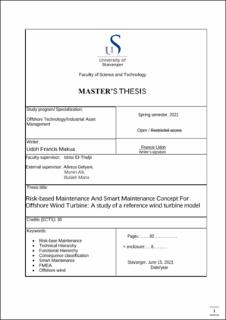| dc.description.abstract | The wind energy sector is the highest trending renewable energy globally, both onshore and offshore. However, the potential for onshore wind power is limited due to some factors, such as land constraints and capacity factor. In contrast, Offshore wind power remains one of the most up-and-coming renewable energy sources. High rate of energy demand, energy security, vast ocean space, and the effort to reduce CO2 emission are some factors propelling the growth of the offshore wind market. As much as the offshore wind can harness more wind resources due to the stronger and consistent wind off the coast, it also increases equipment failure rate, cost of operation & maintenance(O&M), and safety risks associated with maintenance activities. Operation & maintenance is the leading cause of wind turbine downtime, and it is estimated to cost between 20% -30% of the Levelized cost of energy. Although O&M for offshore is still at the early stages compared to the oil & gas sector, it is regarded as a crucial aspect in the development phase. Trying to figure out the best possible way to improve O&M to reduce cost and mitigate other challenges remains a pressing question for wind farm owners and operators. Some Smart technologies applicable for offshore wind maintenance have been identified. One such technology is the digital twins model enabling real-time monitoring of the asset, using an autonomous Drone, Robotics for inspection and repairs, applying machine learning, and big data analytics to enable asset failure prediction and maintenance optimization. However, another puzzling question is how and where to begin?. Additionally, there are no studies on the adoption of Smart maintenance for offshore wind turbine equipment.
Therefore, the purpose of this thesis is to develop a baseline maintenance concept and illustrate how Smart maintenance concept can be applied to the offshore wind sector. Smart maintenance can be described as integrating technology, machines, and humans to build an intelligent and improved maintenance system. By effectively using the Condition Monitoring system (i.e., aided by Big data analysis, machine learning) and the combination of modern autonomous technology, decision alternatives can be optimized to adequately managed maintenance activities.
In order to achieve the aim of the thesis, several maintenance engineering steps were adopted, and these steps follow the risk-based maintenance approach (Base on Norsok-Z-008). This risk-based maintenance approach consists of Technical hierarchy, Functional hierarchy, Consequence classification, FMEA, and Maintenance selection/ Manning study. A reference direct-drive turbine model was studied in order to develop a technical hierarchy of the system where the equipment and maintainable items were grouped according to their hierarchy level using the 1SO 14224 standard. The functional hierarchy and consequence classification were developed to determine the criticality level of the main function and sub-function of the wind turbine equipment (i.e., low, medium, or high criticality). The failure mode and effect analysis (FMEA) was adopted to further analyze high and medium-level critical equipment by defining the root cause of failure in order to focus on the most critical failure mode. This process has enabled the development of the baseline maintenance concept for each selected critical failure mode.
Consequently, this thesis has provided new original knowledge for offshore wind application. It shows that the Risk-based maintenance approach can be transferred from the oil & gas sector to the wind sector as long as it considers the difference in risk-related issues (safety, environment) and takes into account the additional equipment that is not in oil & gas, such as the blade. However, to implement it more efficiently, there is a need for good risk evaluation criteria, reliable failure data (MTTF, MTBF, failure mode), and expert opinion to define special functions. Moreover, the Smart maintenance concept can be integrated into the risk-based maintenance approach at the latter stage. Furthermore, this thesis has developed a Smart maintenance decision workflow to improve the maintenance operations for the offshore wind turbine. The workflow consists of three scenarios [1] Design-out scenario, [2] Condition monitoring scenario, [3] Autonomous solution scenario. These scenarios illustrate the steps, decision processes, and actions involved in implementing smart maintenance concepts for offshore wind turbine equipment. However, it will require implementing multiple scenarios to achieve the full benefit of the Smart maintenance concept.
Nevertheless, this thesis suggests that using autonomous solutions such as drones and repair robotic for some wind turbine maintenance activities such as for blade maintenance might have the potential to increase the availability by 39.83% and reduce safety risks associated with maintenance. It can also reduce total manning hours by 60.16%, which will decrease the maintenance cost eventually. Moreover, using autonomous drones and repair robots is not yet fully automated; it still requires the presence of about two technicians due to technical and safety-related issues. | |
